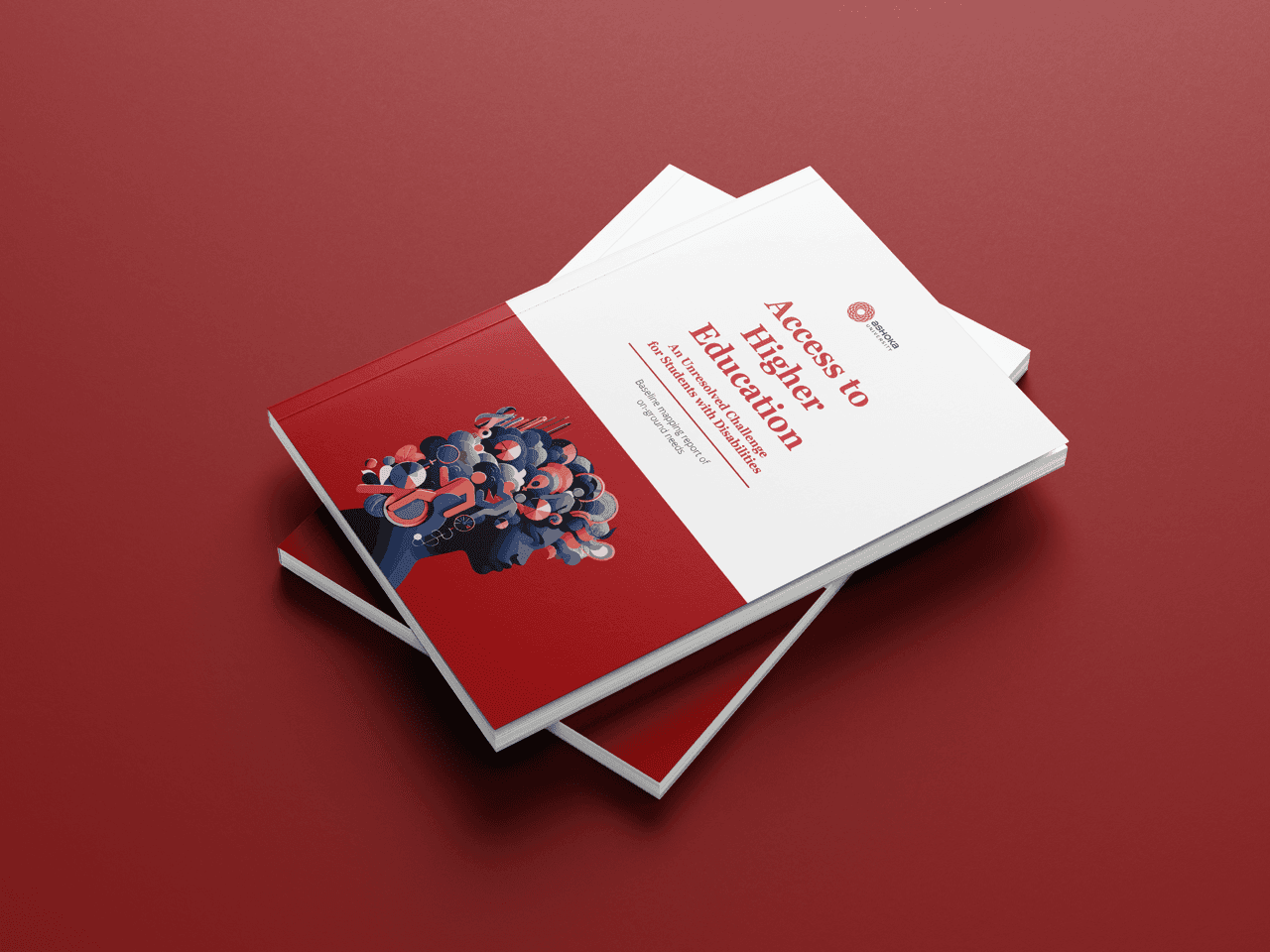
2024
Education
Publication
Disabilities
Ashoka University
Baseline Mapping Report
The Office of Learning Support at Ashoka University compiled their first-ever baseline mapping report highlighting the needs, challenges, and potential solutions for students with disabilities. This report, consisting primarily of text and disjointed data, lacked approachability and failed to effectively highlight crucial information and actionable items. The goal was to transform this report from low impact to high impact through thoughtful design, while also showcasing the office's programs and interventions aimed at fostering inclusion.
A comprehensive publication empowering stakeholders by providing a clear pathway from identifying challenges to devising inclusive solutions.


To achieve these objectives, a new visual language was developed to enhance approachability and engagement for the intended audience. This includes the introduction of new colors, simple layouts, icons, and data visualization to make the content more accessible and visually appealing. A clear information hierarchy was established through structured chapters, contextual callouts, and graphic elements integrated with data. Consistent narrative arc and color blocking was used for subsections to maintain continuity and guide readers through the report. Importantly, the design emphasized a solution-oriented approach to challenges and disabilities, ensuring that actionable insights and interventions were prominently featured.




Structured chapters and visual cues guide readers through key insights and interventions, transforming data into impactful visuals to showcase effective support programs at Ashoka University.



2024
Education
Publication
Disabilities
Ashoka University
Baseline Mapping Report
The Office of Learning Support at Ashoka University compiled their first-ever baseline mapping report highlighting the needs, challenges, and potential solutions for students with disabilities. This report, consisting primarily of text and disjointed data, lacked approachability and failed to effectively highlight crucial information and actionable items. The goal was to transform this report from low impact to high impact through thoughtful design, while also showcasing the office's programs and interventions aimed at fostering inclusion.
A comprehensive publication empowering stakeholders by providing a clear pathway from identifying challenges to devising inclusive solutions.


To achieve these objectives, a new visual language was developed to enhance approachability and engagement for the intended audience. This includes the introduction of new colors, simple layouts, icons, and data visualization to make the content more accessible and visually appealing. A clear information hierarchy was established through structured chapters, contextual callouts, and graphic elements integrated with data. Consistent narrative arc and color blocking was used for subsections to maintain continuity and guide readers through the report. Importantly, the design emphasized a solution-oriented approach to challenges and disabilities, ensuring that actionable insights and interventions were prominently featured.




Structured chapters and visual cues guide readers through key insights and interventions, transforming data into impactful visuals to showcase effective support programs at Ashoka University.



2024
Education
Publication
Disabilities
Ashoka University
Baseline Mapping Report
The Office of Learning Support at Ashoka University compiled their first-ever baseline mapping report highlighting the needs, challenges, and potential solutions for students with disabilities. This report, consisting primarily of text and disjointed data, lacked approachability and failed to effectively highlight crucial information and actionable items. The goal was to transform this report from low impact to high impact through thoughtful design, while also showcasing the office's programs and interventions aimed at fostering inclusion.
A comprehensive publication empowering stakeholders by providing a clear pathway from identifying challenges to devising inclusive solutions.


To achieve these objectives, a new visual language was developed to enhance approachability and engagement for the intended audience. This includes the introduction of new colors, simple layouts, icons, and data visualization to make the content more accessible and visually appealing. A clear information hierarchy was established through structured chapters, contextual callouts, and graphic elements integrated with data. Consistent narrative arc and color blocking was used for subsections to maintain continuity and guide readers through the report. Importantly, the design emphasized a solution-oriented approach to challenges and disabilities, ensuring that actionable insights and interventions were prominently featured.




Structured chapters and visual cues guide readers through key insights and interventions, transforming data into impactful visuals to showcase effective support programs at Ashoka University.



2024
Education
Publication
Disabilities
Ashoka University
Baseline Mapping Report
The Office of Learning Support at Ashoka University compiled their first-ever baseline mapping report highlighting the needs, challenges, and potential solutions for students with disabilities. This report, consisting primarily of text and disjointed data, lacked approachability and failed to effectively highlight crucial information and actionable items. The goal was to transform this report from low impact to high impact through thoughtful design, while also showcasing the office's programs and interventions aimed at fostering inclusion.
A comprehensive publication empowering stakeholders by providing a clear pathway from identifying challenges to devising inclusive solutions.


To achieve these objectives, a new visual language was developed to enhance approachability and engagement for the intended audience. This includes the introduction of new colors, simple layouts, icons, and data visualization to make the content more accessible and visually appealing. A clear information hierarchy was established through structured chapters, contextual callouts, and graphic elements integrated with data. Consistent narrative arc and color blocking was used for subsections to maintain continuity and guide readers through the report. Importantly, the design emphasized a solution-oriented approach to challenges and disabilities, ensuring that actionable insights and interventions were prominently featured.




Structured chapters and visual cues guide readers through key insights and interventions, transforming data into impactful visuals to showcase effective support programs at Ashoka University.

